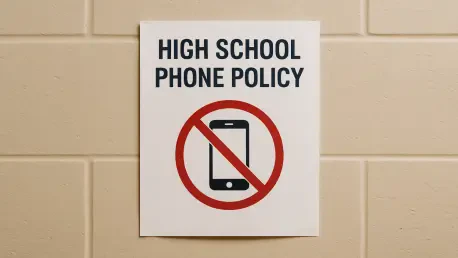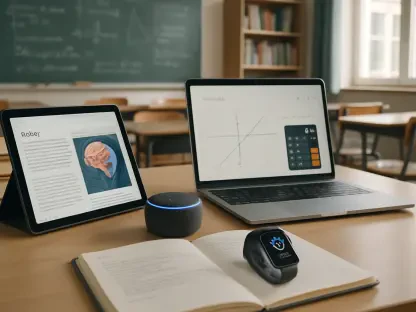In an era where smartphones are nearly ubiquitous among teenagers, Bloomington High School (BHS) in District 87, Bloomington, Illinois, has taken a bold step to address their impact on education by implementing a stringent new cell phone policy. This innovative rule, which completely bans phone use in classrooms during instructional time, represents a significant shift from the previous system where individual teachers dictated their own guidelines, often resulting in inconsistent enforcement and pervasive distractions. The primary objective of this policy is to cultivate a focused learning environment, minimize interruptions, and alleviate the burden on educators who previously struggled with managing varied classroom rules. By standardizing expectations across the board, BHS aims to enhance academic productivity and encourage more meaningful student engagement. Reports from students and staff alike suggest that this change is already yielding promising results, with noticeable improvements in classroom dynamics and student focus. This article delves into the motivations behind the policy, the specific goals it seeks to achieve, and the diverse perspectives from the school community on its effectiveness, painting a comprehensive picture of how this initiative is reshaping the educational experience at BHS.
Addressing Past Challenges
The decision to overhaul phone use regulations at BHS was driven by a pressing need to resolve long-standing issues with inconsistency and distraction in the classroom. Under the old system, teachers had the autonomy to set their own rules, which led to a patchwork of policies across the school. Some educators permitted phones as incentives for good behavior, while others imposed strict bans, creating an environment where students often faced confusion about expectations as they moved from one class to another. This lack of uniformity frequently resulted in smartphones becoming a source of disruption, as students exploited lenient rules to engage in activities unrelated to learning, such as texting or browsing social media. The uneven approach not only undermined academic focus but also placed additional stress on teachers who had to constantly monitor and enforce their individual guidelines. District 87 recognized that a unified policy was essential to eliminate these discrepancies and foster a more cohesive educational setting, prompting the introduction of a blanket ban on phone use during class time at BHS.
This shift to a standardized policy mirrors similar restrictions already in place at other schools within District 87, such as Bloomington Junior High, where younger students have adapted to comparable rules. By aligning BHS with these district-wide efforts, administrators sought to create fairness and predictability for both students and staff. The new regulation ensures that no classroom operates under different expectations, thereby reducing the likelihood of students testing boundaries or feeling unfairly treated. Early feedback from the school community indicates that this consistent framework has begun to address the distractions that once plagued lessons, allowing for a more streamlined focus on education. The move to a unified approach also reflects a broader understanding of the challenges posed by smartphone use in modern schools, positioning BHS as part of a growing trend among educational institutions to prioritize learning over digital temptations.
Goals Behind the Initiative
One of the central aims of the new phone policy at BHS is to provide substantial support to teachers by removing the burden of managing student phone use on an individual basis. Assistant Principal Emily Waddell has emphasized that the previous system placed undue pressure on educators, who often found themselves juggling instruction with the enforcement of personal rules. This inconsistency not only disrupted classroom flow but also led to tension between teachers and students over perceived unfairness. By implementing a school-wide ban on phones during instructional time, the policy allows educators to dedicate their energy to teaching rather than policing behavior. This change is intended to create a more effective classroom dynamic, where the focus remains on delivering quality education without the constant interruption of managing digital devices. Waddell’s insights highlight the administration’s commitment to supporting staff in their primary roles, ensuring that discipline regarding phone use is handled uniformly across the board.
Another critical goal of the policy is to significantly reduce distractions caused by smartphones, which have become a pervasive challenge in educational settings. Whether students are scrolling through social media, playing games, or sending messages, phones often divert attention away from lessons, hindering academic progress. The ban seeks to counteract this by eliminating access to devices during class, encouraging students to engage more deeply with course material and participate actively in discussions. This focus on minimizing interruptions is expected to enhance the overall learning environment, fostering a space where concentration and productivity take precedence. Reports from BHS suggest that this objective is already being met, with many noting a marked improvement in student attentiveness since the policy took effect. By prioritizing a distraction-free atmosphere, the school aims to set a foundation for sustained academic improvement and better interpersonal engagement among students during instructional periods.
Educator Insights on Implementation
English teacher Kristen Siemientkowski offers a valuable perspective on the challenges faced under the previous system, where she and her colleagues had to devise their own methods for controlling phone use with varying degrees of success. Over the years, Siemientkowski experimented with different strategies, often finding them ineffective or met with resistance from students and parents alike. The lack of a cohesive policy meant that conflicts frequently arose, particularly when rules were perceived as arbitrary or inconsistently applied. She has expressed relief at the introduction of the new ban, which provides much-needed clarity and uniformity across classrooms. This standardized approach has reduced friction over phone-related discipline, allowing her to focus on teaching rather than negotiating with students about device use. Siemientkowski’s experience underscores how the policy addresses a critical pain point for educators, streamlining classroom management and creating a more harmonious teaching environment at BHS.
Additionally, Siemientkowski has noted distinct differences in how students across grade levels have adapted to the new restrictions. Younger students, particularly sophomores who encountered similar bans during middle school, have transitioned more smoothly, showing less pushback and quicker compliance with the rules. In contrast, older students, such as juniors and seniors who are accustomed to greater freedom with their devices, initially displayed more resistance to the change. However, even among these groups, adherence has improved over time as the policy became a normalized part of the school routine. This observation points to the importance of prior exposure to structured rules in shaping student behavior and suggests that adaptation is influenced by past experiences with technology restrictions. The varying responses highlight a need for ongoing communication to ensure all students adjust effectively, reinforcing the policy’s intent while addressing initial reluctance among certain age groups.
Student Reactions to the Change
Among the student body, the new phone policy has elicited a range of responses, with many acknowledging tangible benefits in their academic performance. Sophomore KJ King-Warr has reported a significant uptick in grades and assignment completion since the ban was implemented. He attributes this improvement to the absence of phones, which previously pulled focus away from studies through constant notifications and distractions. The policy has cultivated a more concentrated atmosphere in classrooms, enabling students like King-Warr to prioritize learning over digital entertainment. His feedback reflects a broader sentiment among peers who have noticed a positive shift in their ability to stay on task during lessons. This boost in productivity serves as a testament to the policy’s effectiveness in meeting its core objective of enhancing educational outcomes by minimizing the lure of smartphones during critical learning periods.
Beyond academic gains, some students have discovered unexpected social advantages stemming from the phone ban. Senior Gabby Casali has shared that the absence of devices during downtime has led to more direct interactions with classmates. Without the option to retreat into screens, students are engaging in conversations and building connections that might not have occurred otherwise. Casali’s experience points to a subtle but meaningful shift in school culture, where face-to-face communication is becoming more prevalent in the absence of digital distractions. This unintended benefit highlights how the policy not only supports learning but also fosters a sense of community among students, encouraging them to connect on a personal level during breaks or after completing assignments. Such social growth adds another layer of value to the initiative, demonstrating its impact beyond the classroom.
However, not all reactions to the policy are positive, as some students feel constrained by the strict limitations on personal freedom. Senior Emerson Elbert has voiced frustration over the inability to use his phone after finishing classwork, describing periods of boredom where he is left with little to occupy his time. Under the previous system, students often turned to their devices for entertainment or relaxation once tasks were complete, a privilege that the current ban eliminates. Elbert’s sentiment reflects a broader concern among peers who view the restriction as overly rigid, stripping away an outlet during idle moments. This dissatisfaction underscores a challenge in balancing the policy’s academic focus with the need for personal downtime, suggesting that some flexibility might help alleviate feelings of restriction without undermining the primary goals of reducing distractions during active instruction.
Another significant concern raised by students centers on the policy’s impact on emotional well-being, particularly for those who relied on phones as a coping mechanism. Junior Issaria Jacobs has pointed out that many of her peers, including close friends, used music through headphones to manage stress and anxiety during the school day. The ban, which extends to such accessories, has removed this vital outlet, leaving some students feeling unsupported in navigating daily pressures. Jacobs acknowledges that while compliance with the policy has been generally peaceful, the emotional toll of losing this resource is palpable among those who depended on it for comfort. Her perspective sheds light on a critical tension between the policy’s intent to enhance focus and the unintended consequence of limiting tools that support mental health. Addressing this gap could be key to ensuring the policy serves the holistic needs of the student body.
Evaluating the Wider Impact
Overall, feedback from both students and staff at BHS indicates that the phone ban has contributed to a more engaged and productive school environment. The reduction in distractions has allowed classrooms to function with greater efficiency, as students are less likely to be sidetracked by notifications or non-educational content on their devices. Teachers, relieved of the responsibility to enforce disparate rules, can dedicate more time to instruction and student support. This collective improvement in focus has translated into a noticeable shift in the school’s atmosphere, with a stronger emphasis on learning and collaboration. The uniform policy also eliminates confusion about expectations, ensuring that all members of the school community operate under the same guidelines. Such consistency has proven instrumental in fostering a sense of fairness and structure, reinforcing the initiative’s role in enhancing the educational experience.
Nevertheless, the policy’s success is tempered by the ongoing challenge of balancing academic priorities with personal and emotional needs. While the ban has undeniably improved focus during lessons, it has also restricted access to outlets like music or entertainment that some students used to manage stress or boredom after completing work. This tension reveals a nuanced aspect of implementing such a comprehensive restriction, as not all students respond to the change in the same way. The loss of personal freedom, particularly for older students, remains a point of contention that could impact long-term acceptance of the policy. Recognizing and addressing these individual differences is essential to maintaining the initiative’s effectiveness, ensuring it supports both learning goals and the well-being of the student population in a balanced manner.
Furthermore, the varying degrees of adaptation across grade levels suggest that developmental differences play a significant role in how students respond to the policy. Younger students, especially sophomores who experienced similar restrictions in middle school, have adapted with relative ease, showing less resistance to the ban. In contrast, seniors and juniors, who are more accustomed to autonomy with their devices, have faced a steeper adjustment period. This disparity underscores the importance of tailored strategies to support different age groups, perhaps through targeted discussions or gradual implementation for older students. Understanding these developmental nuances can help administrators refine the policy’s rollout, ensuring that all students receive the guidance needed to transition smoothly while maintaining the core focus on minimizing classroom distractions.
Looking ahead, there appears to be room for refinement in the policy to address some of the concerns raised by students while preserving its primary objectives. One potential adjustment could involve allowing limited phone use during designated breaks or after assignments are completed, providing a controlled outlet for entertainment or stress relief without compromising instructional time. Such a compromise might mitigate feelings of boredom and emotional strain, particularly for those who feel the ban is overly restrictive. Additionally, ongoing dialogue between students, teachers, and administrators could help identify further areas for improvement, ensuring the policy evolves in response to feedback. By striking a balance between academic rigor and personal needs, BHS can continue to build on the early successes of this initiative, creating a learning environment that supports both educational achievement and student well-being.
Reflecting on a Path Forward
As the dust settles on the implementation of the new phone policy at BHS, it becomes evident that the initiative has made a meaningful impact on reducing distractions and fostering a more focused educational setting. Teachers have found relief in the standardized approach, which allows them to prioritize instruction over discipline, while many students have noted improvements in their academic performance and social interactions. The uniform ban has successfully addressed the inconsistencies of the past, creating a clearer framework for classroom behavior. Despite initial resistance, particularly from older students, compliance has grown over time, signaling a gradual acceptance of the new norms. The policy’s early achievements lay a strong foundation for enhancing the school’s learning culture, demonstrating the potential for technology restrictions to reshape educational priorities.
Moving forward, the focus should shift to fine-tuning the policy to address lingering concerns and ensure its long-term sustainability. Exploring options such as designated phone-use periods or exceptions for emotional support tools like music could help alleviate some of the frustrations expressed by students. Establishing regular forums for student and staff input would also be a proactive step, allowing the school to adapt the policy based on real-time experiences and evolving needs. By maintaining flexibility and openness to change, BHS can build on the positive outcomes already achieved, ensuring that the ban not only curbs distractions but also nurtures a supportive environment for all members of the school community. This balanced approach could serve as a model for other institutions grappling with similar challenges in the digital age.









